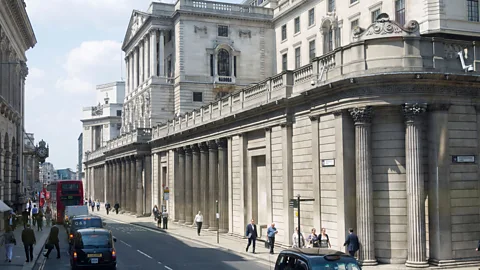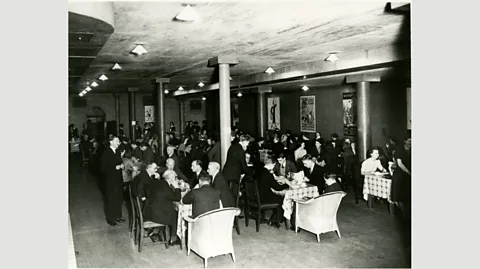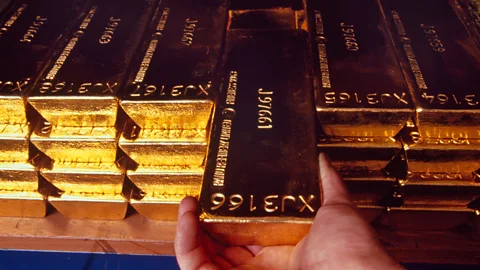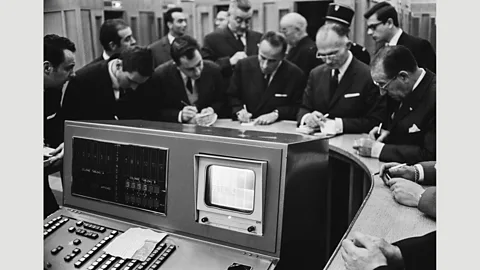The city with $248 billion beneath its pavement
 David Levenson/Alamy
David Levenson/AlamyUnder London’s streets lies a hidden gold mine.
It stretches across more than 300,000 square feet under the City, the finance quarter in the heart of Britain’s capital. There, beneath the pavement and commuters of Threadneedle Street, lies a maze of eight Bank of England gold vaults – each stacked with gold bars worth a total sum of around £141 billion ($200 billion).
The bars sit on rows of blue numbered shelves. Every bar weighs precisely 400 troy ounces (about 12kg), making each currently worth some £350,000 ($500,000), comfortably more than the average price of a house in the UK. Each bar looks subtly different depending on where it was refined. Some bars have sloping edges to make them easier to pick up; others look more like a loaf of bread.
There is no smell here: metal has none. There is no noise, either, on account of the vaults’ thick concrete walls.
 David Levenson/Alamy
David Levenson/AlamyWhat there is, however, is one of the world’s most important traded assets. Deals are still done in gold in almost every country in the world. Its price is a crucial barometer for consumer confidence. Prices rise when markets are uncertain, and before US elections – like now.
“Gold is a hedge against uncertainty,” says Jonathan Spall, a long-time gold trader and now managing director of G Cubed Metal.
These vaults lie right at the heart of this volatile, incredibly important market.
About one-fifth of all the gold held by the world’s governments is in London. In total, 6,256 tonnes of gold are stored in vaults in and around London – collectively worth about £172 billion ($248 billion).
 Mike Booth/Alamy
Mike Booth/AlamyThe Bank of England vaults alone hold 5,134 tonnes, including the official reserves of the UK Treasury and the vast majority of the physical gold traded in London. Gold owned by 30 other countries is also in these vaults along with the hoards of about 25 banks.
So much gold is kept in Britain’s capital partly to keep it near where the metal is traded. It’s also a reflection of the security of London’s vaults.
Hiding your stash
The Bank of England vaults were built in the 1930s. During World War II, when Britain’s bullion was secretly moved to Canada to continue the war effort if Britain was overrun, one vault was used as a staff canteen for Bank of England employees. Vintage advertisements for the P&O cruise line, enticing Bank employees away to holiday, are still plastered across the walls. Later, in the 1940s, the vault was used as a bomb shelter.
 Bank of England
Bank of EnglandBut since 1945, the vaults have been used primarily for gold.
Storing your assets in a huge safe might seem more fitting for a Tudor monarchy than a modern central bank. But the Bank of England still uses not only vaults, but several 3ft-long keys for access. Insiders believe that electronic access alone could be more prone to abuse. (You do still have to speak a password into a microphone and a computer matches your voice against a saved sample).
 David Levenson/Alamy
David Levenson/AlamyThe bars arrive in London by surprisingly traditional methods, too. Some come by sea, shipped from refineries like PAMP in Switzerland or Rand Refinery outside Johannesburg in South Africa.
Gold is also moved on regular passenger aeroplanes. “In the cargo hold of commercial passenger planes, you often find gold, fresh flowers, and dead bodies,” says Ruth Crowell, chief executive of the London Bullion Market Association.
But more difficult than finding transport can be finding a place to house it. Because much of the City of London is on clay ground and because gold is such a dense substance, you can only stack the bars so high before the vault starts sinking into the clay, Crowell says. (The weight of a City skyscraper is spread over a larger footprint, which makes that risk less likely).
This is less of a problem in other cities. In Manhattan, which sits on bedrock, the Federal Reserve Bank can stack bars from floor to ceiling.
 David Levenson/Alamy
David Levenson/AlamyAs a result, there are restrictions on how much gold can be stacked in the Bank’s vaults. On the top level, the gold bars can only be stacked four pallets high. On the lower, they can only be stacked up to six.
This means London needs to spread out its gold more to stop it sinking, and needs more vaults of smaller sizes.
As a result, it isn’t just the City’s streets that are paved with gold. There are seven smaller vaults inside the M25 (the motorway that encircles Greater London) owned by banks like JP Morgan and HSBC, including three at transport companies around Heathrow Airport.
Each owner attempts to keep their vault’s location secret. When CNBC journalists visited JP Morgan in 2011, for example, they had to surrender their mobile phones and travel in a car with blacked-out windows.
Getting your gold fix
It isn’t just vault locations that are kept under wraps. The gold market itself is secretive and steeped in tradition and ritual, particularly around the fixing system used for setting the price.
The price setting meetings or “fixes” – in which there are now 12 direct participants hailing from the UK, US, Canada, China and France – take place twice a day. When a price matches supply and demand, the price is fixed.
Until 2015, this was done verbally: a chairman would try different prices on the participants, each of whom would say if, at that price, they would be buyers or sellers. From 1919 until 2004 fixes were done in person in the City of London. Originally, if a participant wished to pause proceedings – to change between buying and selling, for example – he would raise a small UK flag.
 Reg Lancaster/Daily Express/Getty
Reg Lancaster/Daily Express/GettyIn 2004, the fixes were moved to a conference call. Only last year did the system change to a more modern electronic auction platform run by the Intercontinental Exchange, which also owns the New York Stock Exchange.
“If everyone knows there are two key points in the day to show up, you get the best liquidity balance between buying and selling,” says Matthew Glenville, chief operating officer of the Intercontinental Exchange Benchmark Administration.
 David Levenson/Alamy
David Levenson/AlamyThis ‘spot’ price is then used as a benchmark for people buying and selling gold around the world, a market where transactions total around £85 billion ($120 billion) a day.
Portable assets
During good times, gold is less in demand. But when the economy is tough, the metal is highly prized as a safe haven asset – not quite like storing cash under the mattress, but still a way to hedge against risk in other markets.
As a result, gold increases in value when markets are volatile. Since the 1,000-point Dow Jones plunge of August 2015, the average price of the morning fix has increased each month, rising from £705 ($1,000) in December to £870 ($1,250) in March. When stock markets slump, governments and private investors ditch equities and buy gold – like Russia and China are doing now.
 Dibyangshu Sarkar/AFP/Getty
Dibyangshu Sarkar/AFP/GettyEven so, only 32% of the world’s yellow metal is actually held by governments, banks and investors under lock and key. About 12% is used industrially, such as in electronics circuits. And more than half is used for jewellery.
China and India are particularly significant markets for jewellery, together accounting for half of world demand. In India alone, an average of 30 to 40 grams of gold are purchased for each of the country’s 10 million weddings each year.
“China and India, between the two of them, accounted for less than 10% of global demand in 2000,” says Ross Norman, chief executive of the bullion dealer Sharps Pixley. “Now it’s north of 90%.”
 Sam Panthaky/AFP/Getty
Sam Panthaky/AFP/GettyWith the current volatility of major currencies and stock markets, it’s little surprise that gold has returned to fashion. One sign? The opening of London’s first high street gold showroom in January.
Sharps Pixley is located directly across from the private clubs White’s and Boodle’s in the heart of the upmarket St James’s neighbourhood. The building, which is owned by The Apprentice star Lord Sugar, has an exclusive and club-like interior with dark timber, brass and a large chandelier.
If you want to get your hands on some bullion today, Sharps Pixley sells gold over the counter, in bars ranging from a kilogram (£28,058) down to one gram (£33.89).
But with prices on the increase, you’d best bring your gold card.
This story is a part of BBC Britain – a series focused on exploring this extraordinary island, one story at a time. Readers outside of the UK can see every BBC Britain story by heading to the Britain homepage; you also can see our latest stories by following us on Facebook and Twitter.
To comment on this story or anything else you have seen on BBC Capital, head over to our Facebook page or message us on Twitter.
If you liked this story, sign up for the weekly bbc.com features newsletter, called “If You Only Read 6 Things This Week”. A handpicked selection of stories from BBC Future, Earth, Culture, Capital, Travel and Autos, delivered to your inbox every Friday.
